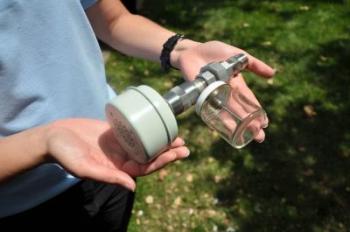May 14 2013
Inspired by two of their fathers, who work cutting lawns and driving a truck, a team of University of California, Riverside Bourns College of Engineering students have created a device that attaches to a lawnmower and significantly cuts its harmful emissions.
 This is the device team NOx-Out built to attach to lawnmowers to cut emissions. Credit: UC Riverside
This is the device team NOx-Out built to attach to lawnmowers to cut emissions. Credit: UC Riverside
The creation of the device comes at an opportune time. Recently, the California Air Resources Board implemented regulations to reduce the amount of emissions from lawnmowers and other small engine devices, such as leaf blowers, dirt bikes and snowmobiles. With some design modifications, the student-made device could also be used on those other devices.
Regulations are tightening on lawn mowers and other small engine devices because studies have shown they produce between 100 to 1,000 times more emissions than automobiles over the same operating time. While emissions from large engines, such as those in automobiles and trucks, are well regulated, regulations for small engines have traditionally been overlooked.
The team, which calls itself NOx-Out, believes there is a market for the device from lawnmower manufacturers who are subject to the new regulatory rules in California. They also think there is a market for current lawnmower owners who could retrofit their existing gasoline-powered lawnmower with the students' device to create a more environmentally friendly lawnmower. It also has the added benefit of reducing noise from the lawnmower and the smell of gasoline.
The team of students – Joshua Callihan, Rosalva Chavez, Jonya Blahut, Risa Guysi and Holly Clarke, who are all seniors – recently won two first place awards at the WERC: A Consortium for Environmental Education and Technology Development competition in Las Cruces, N.M. It's run by the Institute for Energy & the Environment (IEE).
The team shared a first place honor in one category and won first place in the peer award category, which is judged by students at the competition. In total, they won $2,250. They are advised by Kawai Tam, a lecturer at the Bourns College of Engineering.
The team, who are all environmental engineering majors with the exception of Callihan, a chemical engineering major, created a device that can be attached to a lawnmower in the place of the muffler.
When they tested it at the Bourns College of Engineering Center for Environmental Research and Technology, it reduced the following harmful pollutants: carbon monoxide (CO) by 87 percent; nitrogen oxides (NOx) by 67 percent and particulate matter (PM) by 44 percent.
The idea for the device originated about a year ago. Chavez had a conversation with a member from a UC Riverside team that won awards at last year's WERC competition. That team member mentioned that the judges were interested in small engine projects. Chavez thought of her father. He cuts lawns to earn extra money and had developed asthma. She wondered whether the two were linked.
After Chavez talked to her father, Blahut had a conversation with her father, who is a truck driver and recently had to retrofit his truck with a particulate matter filter. She wondered whether a similar filter could be attached to a lawnmower. She and her teammates decided to find out.
They found out it could. The device created by the students is about six inches long. It consists of a filter, a glass jar that holds two ounces of urea solution, the original lawnmower muffler, which the students modified by packing with a catalyst they created, and a series of stainless steel nuts and bolts that connect everything and attached to the lawnmower muffler port.
The device can be thought of as a three stage system. First, a glass quartz filter captures particulate matter. Then an ultra-fine spray of urea solution is dispersed into the exhaust stream. The urea spray primes the dirty air for the final stage, when a catalyst converts the harmful nitrogen oxide and ammonia into harmless nitrogen gas and water and releases them into the air.
The key to the process is the catalyst the students developed. The students do not want to identify what it is made of because it is a novel product that they are considering patenting. Similar catalysts have been developed for diesel fuel, but not for gasoline.
They expect to sell the device for $30, which would also include a 16-ounce refill bottle of the urea solution and 10 quartz replacement filters.
The students plan to improve the design. They would like to replace the glass jar with another material that is less prone to being broken. They also want to design and machine a single piece of stainless steel to replace the various nuts and bolts they have connected now to form the device.
They are considering starting their own company to sell the device or selling the idea to manufacturer of lawnmowers. They say there is no similar aftermarket emission control device available for lawnmowers.
The team was sponsored by Watson Bros.; OXY USA Inc. LA Basin Asset; BPS – Long Beach, a UC Riverside Undergraduate Research Grant; UC Riverside's College of Engineering Center for Environmental Research and Technology; Signal Hill Petroleum; Bill Summerfield, who works at Signal Hill Petroleum; and Don Clarke, who is Holly Clarke's father.
The team also received assistance from two UC Riverside professors: David Cocker, a professor of chemical and environmental engineering, and Phil Christopher, an assistant professor of chemical and environmental engineering.